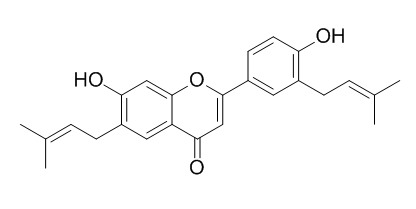Licoflavone B
Licoflavone B has schistosomicidal activity, it showed high S. mansoni ATPase (IC50 of 23.78 uM) and ADPase (IC50 of 31.50 uM) inhibitory activities.
Inquire / Order:
manager@chemfaces.com
Technical Inquiries:
service@chemfaces.com
Tel:
+86-27-84237783
Fax:
+86-27-84254680
Address:
1 Building, No. 83, CheCheng Rd., Wuhan Economic and Technological Development Zone, Wuhan, Hubei 430056, PRC
Providing storage is as stated on the product vial and the vial is kept tightly sealed, the product can be stored for up to
24 months(2-8C).
Wherever possible, you should prepare and use solutions on the same day. However, if you need to make up stock solutions in advance, we recommend that you store the solution as aliquots in tightly sealed vials at -20C. Generally, these will be useable for up to two weeks. Before use, and prior to opening the vial we recommend that you allow your product to equilibrate to room temperature for at least 1 hour.
Need more advice on solubility, usage and handling? Please email to: service@chemfaces.com
The packaging of the product may have turned upside down during transportation, resulting in the natural compounds adhering to the neck or cap of the vial. take the vial out of its packaging and gently shake to let the compounds fall to the bottom of the vial. for liquid products, centrifuge at 200-500 RPM to gather the liquid at the bottom of the vial. try to avoid loss or contamination during handling.
Korean j.of Pharm.2017, 70-76
LWT2024, v208:116677
J Pharmaceut Biomed2020, 182:113110
J Ethnopharmacol.2017, 209:305-316
Exp Mol Med.2020, 52(4):629-642.
Korean J. Food Preserv.2023, 30(4):663-668.
Pharmacognosy Journal2019, 11(2): 369-373
Food Funct.2024, 15(4):1852-1866.
J Sci Food Agric.2018, 98(3):1153-1161
Genes (Basel).2021, 12(7):1024.
Related and Featured Products
J Nat Prod. 2014 Mar 28;77(3):563-70.
Computer-guided approach to access the anti-influenza activity of licorice constituents.[Pubmed:
24313801 ]
Neuraminidase (NA), a key enzyme in viral replication, is the first-line drug target to combat influenza. On the basis of a shape-focused virtual screening, the roots of Glycyrrhiza glabra (licorice) were identified as plant species with an accumulation of constituents that show 3D similarities to known influenza NA inhibitors (NAIs).
METHODS AND RESULTS:
Phytochemical investigation revealed 12 constituents identified as (E)-1-[2,4-dihydroxy-3-(3-methyl-2-butenyl)phenyl]-3-(8-hydroxy-2,2-dimethyl-2H-1-benzopyran-6-yl)-2-propen-1-one (1), 3,4-dihydro-8,8-dimethyl-2H,8H-benzo[1,2-b:3,4-b']dipyran-3-ol (2), biochanin B (3), glabrol (4), glabrone (5), hispaglabridin B (6), Licoflavone B (7), licorice glycoside B (8), licorice glycoside E (9), liquiritigenin (10), liquiritin (11), and prunin (12). Eleven of these constituents showed significant influenza virus NA inhibition in a chemiluminescence (CL)-based assay. Additional tests, including (i) a cell-based cytopathic effect inhibition assay (general antiviral activity), (ii) the evaluation of cytotoxicity, (iii) the inhibition of the NA of Clostridium perfringens (CL- and fluorescence (FL)-based assay), and (iv) the determination of self-fluorescence and quenching, provided further perspective on their anti-influenza virus potential, revealing possible assay interference problems and false-positive results.
CONCLUSIONS:
Compounds 1, 3, 5, and 6 showed antiviral activity, most likely caused by the inhibition of NA. Of these, compounds 1, 3, and 6 were highly ranked in shape-focused virtual screening.
Exp Parasitol. 2015 Dec;159:207-14.
Schistosomicidal activity and docking of Schistosoma mansoni ATPDase 1 with licoflavone B isolated from Glycyrrhiza inflata (Fabaceae).[Pubmed:
26454044]
Schistosomiasis is one of the world's major public health problems, and its treatment is widely dependent on praziquantel (PZQ), the only available drug. Schistosoma mansoni ATP diphosphohydrolases are ecto-enzymes localized on the external tegumental surface of S. mansoni and considered an important target for action of new drugs.
METHODS AND RESULTS:
In this work, the in vitro schistosomicidal activity of the crude extract of Glycyrrhiza inflata roots (GI) and its isolated compounds echinatin, licoflavone A and Licoflavone B were evaluated against S. mansoni adult worms. Results showed that GI (200 μg/mL) was active against adult schistosomes, causing 100% mortality after 24 h of incubation. Chromatographic fractionation of GI led to isolation of echinatin, licoflavone A and Licoflavone B. Licoflavone B (25-100 μM) caused 100% mortality, tegumental alterations, and reduction of oviposition and motor activity of all adult worms, without affecting mammalian Vero cells. Confocal laser scanning microscopy showed tegumental morphological alterations and changes on the numbers of tubercles of S. mansoni worms in a dose-dependent manner after incubation with Licoflavone B. Licoflavone B also showed high S. mansoni ATPase (IC50 of 23.78 μM) and ADPase (IC50 of 31.50 μM) inhibitory activities. Docking studies predicted different interactions between Licoflavone B and S. mansoni ATPDase 1, corroborating with the in vitro inhibitory activity.
CONCLUSIONS:
This report demonstrated the first evidence for the schistosomicidal activity of Licoflavone B and suggests that its mechanism of action involve the inhibition of S. mansoni ATP diphosphohydrolases.



